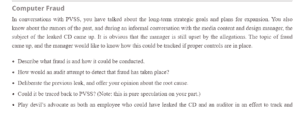Computer Fraud
Describe what fraud is and how it could be conducted.
Computer fraud entails using a computer to modify or gain access to electronic data or unlawfully obtaining access to a computer or system. Computer fraud can be conducted in the following ways.
- Distribution of hoax emails.
- Mining of data through malware and spyware.
- Getting unauthorized access to computers.
- Propagating computer viruses and worms to destroy a computer system of another party intentionally.
- Hacking into computers to get unauthorized access to personal information such as social security and credit card numbers.
Would you like to have an original copy of “Computer Fraud”? Feel free to get in touch with us.
How would an audit attempt to detect that fraud have taken place?
Audits focus on internal controls, which are the checkpoints of business transaction flow. The checkpoints are where the transactions are approved, documented, and sent to different departments or persons for some further action or authorization. At the checkpoints, the internal controls have a requirement that must be validated and a paper trail. Auditing for fraud examines a particular department’s internal controls. It then analyses the source documents that the transactions generated in the department to determine if they were altered or forged.
An audit checks the activity of the account for any irregularities. The online versions are viewed to detect fraud early, and appropriate action is taken in case of suspicious activity.
Deliberate the previous leak, and offer your opinion about the root cause.
A lack of clear moral direction from the senior management was shown during a previous leak. Since leadership comes from the top, if top managers participate in semi-corrupt behaviors, such as adjusting their expense claims upwards, the other employees may feel compelled to participate in fraudulent activities (Pomeranz, 2005). Additionally, the arrogance of some employees leads to the twisted belief that they are better than the systems in place. They have the idea that they can do anything and escape it. To this extent, an employee can do fraudulent activities with impunity.
Could it be traced back to PVSS? (Note: this is pure speculation on your part.)
The fraud is unlikely to be linked to the PVSS since it allows a prover to prove with verification that a value with specific properties has been shared with several parties. Anyone can perform this verification, making it difficult for an employee to leak the CD through the PVSS. PVSS can improve multiple applications, such as universally verifiable electronic voting, fair electronic cash, and software key escrow schemes (Young & Yung, 2001). In this regard, an employee will know the capabilities of PVSS and would hesitate before using it to commit fraud.
Play devil’s advocate as an employee who could have leaked the CD and an auditor to track and catch the employee.
Information leakage, detection, and prevention (ILDP) is the new concern in information security. Initially, the main focus was on detecting and preventing intrusions; however, adequate measures must not be taken to avoid extrusions. The extrusions pose a significant risk, yet most organizations do not have the solutions in ILDP. In this case, an employee leaked a CD containing information about the organization. The leak could be caused by intentional sabotage or negligence (Chee, 2007). An email could have been sent to the unintended recipient. Apart from failure, it is universally true that no matter the countermeasures, the motivations for leaking sensitive information will still exist. The storage media, which are becoming increasingly smaller and mobile, are more likely to be stolen or lost. The potential employee to leak the information must have a motive, such as intentional sabotage. A thorough check of the recent organizational activities can determine any employee with an ill explanation towards the organization, such as one whose promotion was declined.
Similar Post: How Have We Evolved in the Management Field
References
Chee, W. O. (2007). Information Leakage, Detection, and Prevention. ISSA The Global Voice of Information Security, ISSA Journal.
Young, A., & Yung, M. (2001, February). IN INTERNATIONAL WORKSHOP ON PUBLIC KEY CRYPTOGRAPHY, a PVSS is as stiff as a discrete log and shareholder separability (pp. 287-299). Springer, Berlin, Heidelberg.
Pomeranz, F. (2005). Fraud: The root causes. Public Money & Management, 15(1), 15-18.
ORDER A PLAGIARISM-FREE PAPER HERE
We’ll write everything from scratch
Question
Computer Fraud
In conversations with PVSS, you have talked about the long-term strategic goals and plans for expansion. You also know about the rumors of the past, and during an informal conversation with the media content and design manager, the subject of the leaked CD came up. The manager is still upset by the allegations. The topic of fraud came up, and the manager would like to know how this could be tracked if proper controls are in place.

Computer Fraud
- Describe what fraud is and how it could be conducted.
- How would an audit attempt to detect that fraud have taken place?
- Deliberate the previous leak, and offer your opinion about the root cause.
- Could it be traced back to PVSS? (Note: this is pure speculation on your part.)
- Play devil’s advocate as an employee who could have leaked the CD and an auditor to track and catch the employee.

